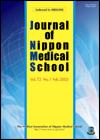Volume 81, Issue 4
Displaying 1-14 of 14 articles from this issue
- |<
- <
- 1
- >
- >|
Photogravure
-
2014Volume 81Issue 4 Pages 192-193
Published: 2014
Released on J-STAGE: September 03, 2014
Download PDF (245K)
Reviews
-
2014Volume 81Issue 4 Pages 194-202
Published: 2014
Released on J-STAGE: September 03, 2014
Download PDF (150K) -
2014Volume 81Issue 4 Pages 203-210
Published: 2014
Released on J-STAGE: September 03, 2014
Download PDF (255K)
Originals
-
2014Volume 81Issue 4 Pages 211-220
Published: 2014
Released on J-STAGE: September 03, 2014
Download PDF (342K) -
2014Volume 81Issue 4 Pages 221-235
Published: 2014
Released on J-STAGE: September 03, 2014
Download PDF (828K) -
2014Volume 81Issue 4 Pages 236-247
Published: 2014
Released on J-STAGE: September 03, 2014
Download PDF (734K) -
2014Volume 81Issue 4 Pages 248-257
Published: 2014
Released on J-STAGE: September 03, 2014
Download PDF (374K)
Report on Experiments and Clinical Cases
-
2014Volume 81Issue 4 Pages 258-263
Published: 2014
Released on J-STAGE: September 03, 2014
Download PDF (132K)
Case Reports
-
2014Volume 81Issue 4 Pages 264-268
Published: 2014
Released on J-STAGE: September 03, 2014
Download PDF (583K) -
2014Volume 81Issue 4 Pages 269-275
Published: 2014
Released on J-STAGE: September 03, 2014
Download PDF (632K) -
2014Volume 81Issue 4 Pages 276-284
Published: 2014
Released on J-STAGE: September 03, 2014
Download PDF (474K)
Short Communications
-
2014Volume 81Issue 4 Pages 285-288
Published: 2014
Released on J-STAGE: September 03, 2014
Download PDF (52K) -
2014Volume 81Issue 4 Pages 289-291
Published: 2014
Released on J-STAGE: September 03, 2014
Download PDF (45K)
Abstracts of the 2011th Alumni Association Memorial Lectures of the 80st Annual Meeting of the Medical Association of Nippon Medical School
-
2014Volume 81Issue 4 Pages 292-293
Published: 2014
Released on J-STAGE: September 03, 2014
Download PDF (34K)
- |<
- <
- 1
- >
- >|
